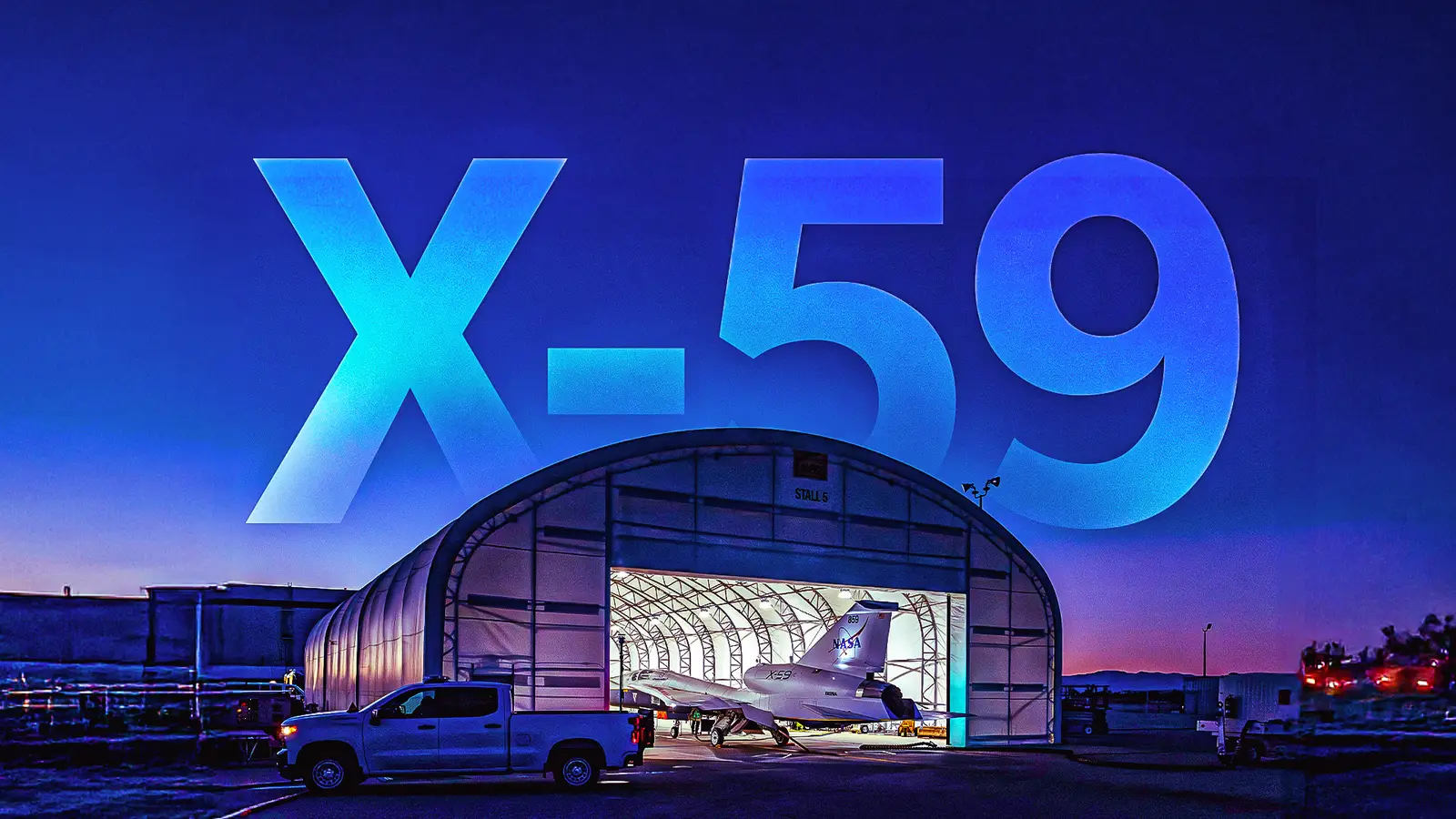Copyright Simple Flying

Can supersonic flight ever return to the skies in a way that’s quiet, sustainable, and legal over land? That’s the question NASA hopes to answer with its sleek, needle-nosed experimental jet, the X-59 Quiet Supersonic Technology Demonstrator (QueSST). Having recently completed medium- and high-speed taxi tests at Lockheed Martin’s Skunk Works facility in Palmdale, California, in September 2025, the aircraft has moved one step closer to redefining how fast, long-haul flight could sound, or rather, not sound, to those below. As part of the NASA–Lockheed Martin QueSST mission, the X-59 aims to prove that the infamous “sonic boom” of supersonic travel can be severely reduced. The data it will gather over the next few years could be the foundation for new regulations that one day allow commercial supersonic aircraft to fly coast-to-coast, cutting transcontinental flight times nearly in half. This article explores what the X-59 has achieved so far, how it works, what lies ahead, and what this means for the next era of high-speed aviation. What Exactly Is The X-59, And Why Does It Matter? Unveiled by NASA and Lockheed Martin on January 12, 2024, the X-59 is a one-of-a-kind experimental aircraft designed to demonstrate quiet supersonic flight. Built by Lockheed Martin’s Skunk Works, the jet is part of NASA’s long-running Low-Boom Flight Demonstration (LBFD) program. With its 99 feet (30.1 meters) fuselage and dramatically pointed nose, the aircraft looks like a cross between a fighter and a dart, but every contour serves one purpose: controlling how sound moves through the air. Its purpose is entirely civil, to show that supersonic flight can coexist with communities below. Traditional supersonic aircraft like Concorde and the F-104 Starfighter generated sonic booms exceeding 100 decibels, loud enough to rattle windows and spark noise complaints across cities. The X-59, however, aims to keep its sonic signature below 75 Perceived Level decibels (PLdB), a specialized acoustic metric for impulsive sounds like sonic booms, roughly comparable to a car door slamming from a distance. Unlike standard A-weighted decibel, dB(A), measurements used for continuous environmental noise, PLdB accounts for the brief, sharp nature of sonic booms, making direct comparisons to everyday sounds approximate. To achieve this, NASA’s engineers have shaped the jet’s fuselage to control how shockwaves merge, spreading them across time and space so the sharp “boom” becomes a gentle “thump.” Unlike military prototypes, the X-59 isn’t chasing speed records. It’s designed to cruise at Mach 1.4 (approximately 925 miles per hour / 1,488 kilometers per hour) and 55,000 feet (16,764 meters). The mission’s value lies in its ability to collect human feedback: NASA plans to fly the X-59 over select US cities beginning in 2026, recording how communities perceive the sound. The results will be given to the Federal Aviation Administration (FAA) and ICAO, potentially rewriting a 50-year-old ban on supersonic travel over land. What Factors Have Influenced X-59’s Progress? Developing a supersonic aircraft that’s both quiet and stable has taken longer than NASA initially planned. The X-59’s progress has been shaped by a combination of aerodynamic complexity, regulatory coordination, and engineering precision. The project’s early delays were due to the intricate task of integrating flight control systems, engine placement, and acoustic modeling. Lockheed Martin installed the aircraft’s single General Electric F414-GE-100 turbofan engine, the same powerplant found in the Boeing F/A-18 Super Hornet, within the upper fuselage. This top-mounted engine helps deflect the exhaust plume away from the ground, contributing modestly to noise reduction, though the primary noise-reduction strategy is the aircraft’s aerodynamic shaping. In a way, the X-59 evokes the pioneering spirit of the Spirit of St. Louis: Lindbergh’s record-breaking aircraft was built for the transatlantic journey, so it flew without a forward windshield to make room for fuel tanks, making a generational leap in aviation history. Similarly, NASA’s sleek supersonic demonstrator lacks a windshield to accomplish its mission, relying on technology rather than direct sight. Its eXternal Vision System (XVS) gives pilots a digitally enhanced view of the horizon, a technical solution that could redefine how humans and machines navigate the sky. Together, these design decisions helped NASA validate its computational models during ground acoustic tests in 2023. Initial results from wind tunnel tests and subscale models showed that predicted noise levels are promising, though full-scale, real-world acoustic validation awaits overflight tests starting in 2026. The program’s next milestone was achieved in September 2025 when the X-59 performed medium- and high-speed taxi tests at Skunk Works, confirming brake systems, steering, and telemetry before its first flight later that year. Inside NASA’s Quesst Mission NASA’s Quesst program is not a typical research venture, it’s a decade-long international collaboration combining public resources with private aerospace expertise. The X-59 is being built by Lockheed Martin’s Skunk Works division under a $247.5 million contract, leveraging the same rapid prototyping methods that once produced icons like the SR-71 Blackbird and F-117 Nighthawk. The aircraft’s purpose is singular but profound: to gather data on community response to low-boom supersonic flight, paving the way for regulators to revisit the ban on overland supersonic travel. The test campaign will unfold in three main phases. The first focuses on envelope expansion and supersonic validation from NASA’s Armstrong Flight Research Center in California. The second involves acoustic testing across remote US sites to record how the jet’s sonic signature compares to traditional sonic booms. Finally, NASA will bring the X-59 to select US cities, measuring how real communities perceive and react to the sound. These results will feed directly into new FAA and ICAO standards for commercial supersonic flight, an essential step before any airline can plan such routes. If successful, Quesst could become one of the most influential aeronautics programs since Concorde, not for what it builds, but for what it makes possible. The lessons learned from the X-59’s slender fuselage, digital vision system, and low-boom shaping may inspire a generation of commercial aircraft that travel faster than sound without breaking laws, windows, or trust in aviation’s environmental future. How Does The X-59 Compare To Past And Future Supersonic Aircraft? From a distance, the X-59 may evoke memories of Concorde, but the two aircraft could hardly be more different. While Concorde prioritized speed and prestige, flying at Mach 2.04 and 60,000 feet (18,288 meters), the X-59’s focus is on quietness, not velocity. It’s smaller, lighter, and carries only one pilot, but the aerodynamic principles it tests might one day allow larger passenger aircraft to fly quietly over populated areas. Unlike military platforms such as the SR-71 Blackbird or F-22 Raptor , the X-59 has no stealth coating. It uses its F414 engine efficiently within an optimized inlet to achieve its supersonic goal while remaining fuel-conscious. After decades of research, the X-59 represents the most advanced stage of a lineage that began with the Bell X-1, continued through Concorde, and matured with reconnaissance giants like the SR-71. But as NASA paves the way for a new generation of overland supersonic travel, commercial innovators are preparing to take the baton. That’s where Boom Supersonic’s Overture enters the picture. If the X-59 defines what is technically possible, Overture seeks to define what is commercially viable. Under development in Greensboro, North Carolina, Boom’s flagship airliner aims to carry between 64 and 80 passengers at Mach 1.7 and 60,000 feet (18,288 meters). The company envisions a future where major city pairs, such as New York City to London , Washington DC to Paris , or Boston to Los Angeles , can be connected in half the current travel time. Yet, for this vision to materialize, regulations on overland supersonic flight must first change, and NASA’s X-59 project could provide the critical acoustic data to make that possible. Boom's demonstrator, XB-1, achieved its first supersonic flight in January 2025, marking a key milestone toward Overture's development. Are There Challenges Or Drawbacks To Overcome? Despite progress, several hurdles remain before quiet supersonic flight can enter commercial service. Certification frameworks for supersonic aircraft are still evolving, and NASA must first validate the community response data from its upcoming test flights over the US. Another limitation is the X-59’s single-engine design, which provides efficiency but limits redundancy compared with multi-engine configurations. Operational noise varies with atmospheric conditions, meaning that the “quiet boom” may still fluctuate between 70 and 80 PLdB. Furthermore, the aircraft’s long, narrow structure restricts internal payload, fine for research, but not for passengers. In short, while the X-59 represents the most promising step yet toward reintroducing supersonic travel, the path to quiet, practical passenger service remains complex. NASA has emphasized transparency: the QueSST program’s acoustic data will be released publicly to ensure that global regulators can evaluate its findings together. What’s Next For NASA’s Supersonic Program? Following successful taxi tests, the X-59’s first flight is expected in late 2025, marking the start of a two-year campaign of community response flights. NASA will partner with local governments to measure how residents react to the aircraft’s sonic signature, using microphones, surveys, and environmental sensors to gather data. If the results match expectations, NASA plans to submit formal noise data to the FAA by 2027. This could lead to the first regulatory draft for civilian supersonic corridors over the continental United States since the early 1970s. Commercial manufacturers like Boom Supersonic are already designing aircraft to comply with potential “low-boom” standards inspired by NASA’s findings. While passengers may not step aboard a quiet supersonic airliner for another decade, an estimate based on regulatory, technological, and industry timelines, the X-59’s success could open the sky to a new era of speed, where the world’s continents are connected by sound that’s heard only as a whisper. For an industry that’s spent half a century grounded below the speed of sound, that future suddenly feels closer than ever.



